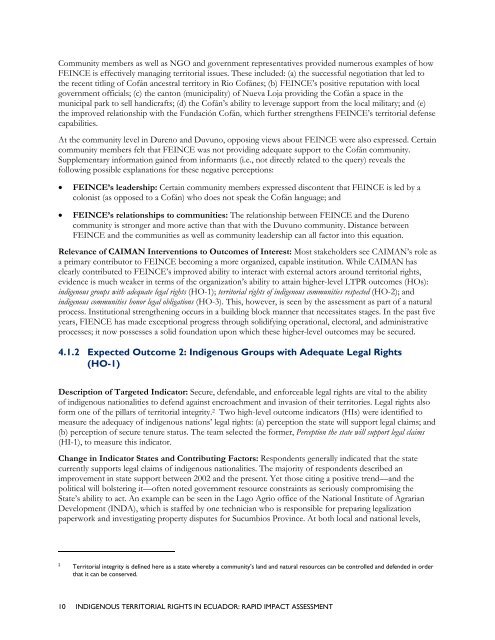ECUADOR - Land Tenure and Property Rights Portal
ECUADOR - Land Tenure and Property Rights Portal
ECUADOR - Land Tenure and Property Rights Portal
- No tags were found...
You also want an ePaper? Increase the reach of your titles
YUMPU automatically turns print PDFs into web optimized ePapers that Google loves.
Community members as well as NGO <strong>and</strong> government representatives provided numerous examples of howFEINCE is effectively managing territorial issues. These included: (a) the successful negotiation that led tothe recent titling of Cofán ancestral territory in Rio Cofánes; (b) FEINCE’s positive reputation with localgovernment officials; (c) the canton (municipality) of Nueva Loja providing the Cofán a space in themunicipal park to sell h<strong>and</strong>icrafts; (d) the Cofán’s ability to leverage support from the local military; <strong>and</strong> (e)the improved relationship with the Fundación Cofán, which further strengthens FEINCE’s territorial defensecapabilities.At the community level in Dureno <strong>and</strong> Duvuno, opposing views about FEINCE were also expressed. Certaincommunity members felt that FEINCE was not providing adequate support to the Cofán community.Supplementary information gained from informants (i.e., not directly related to the query) reveals thefollowing possible explanations for these negative perceptions:• FEINCE’s leadership: Certain community members expressed discontent that FEINCE is led by acolonist (as opposed to a Cofán) who does not speak the Cofán language; <strong>and</strong>• FEINCE’s relationships to communities: The relationship between FEINCE <strong>and</strong> the Durenocommunity is stronger <strong>and</strong> more active than that with the Duvuno community. Distance betweenFEINCE <strong>and</strong> the communities as well as community leadership can all factor into this equation.Relevance of CAIMAN Interventions to Outcomes of Interest: Most stakeholders see CAIMAN’s role asa primary contributor to FEINCE becoming a more organized, capable institution. While CAIMAN hasclearly contributed to FEINCE’s improved ability to interact with external actors around territorial rights,evidence is much weaker in terms of the organization’s ability to attain higher-level LTPR outcomes (HOs):indigenous groups with adequate legal rights (HO-1); territorial rights of indigenous communities respected (HO-2); <strong>and</strong>indigenous communities honor legal obligations (HO-3). This, however, is seen by the assessment as part of a naturalprocess. Institutional strengthening occurs in a building block manner that necessitates stages. In the past fiveyears, FIENCE has made exceptional progress through solidifying operational, electoral, <strong>and</strong> administrativeprocesses; it now possesses a solid foundation upon which these higher-level outcomes may be secured.4.1.2 Expected Outcome 2: Indigenous Groups with Adequate Legal <strong>Rights</strong>(HO-1)Description of Targeted Indicator: Secure, defendable, <strong>and</strong> enforceable legal rights are vital to the abilityof indigenous nationalities to defend against encroachment <strong>and</strong> invasion of their territories. Legal rights alsoform one of the pillars of territorial integrity. 2 Two high-level outcome indicators (HIs) were identified tomeasure the adequacy of indigenous nations’ legal rights: (a) perception the state will support legal claims; <strong>and</strong>(b) perception of secure tenure status. The team selected the former, Perception the state will support legal claims(HI-1), to measure this indicator.Change in Indicator States <strong>and</strong> Contributing Factors: Respondents generally indicated that the statecurrently supports legal claims of indigenous nationalities. The majority of respondents described animprovement in state support between 2002 <strong>and</strong> the present. Yet those citing a positive trend—<strong>and</strong> thepolitical will bolstering it—often noted government resource constraints as seriously compromising theState’s ability to act. An example can be seen in the Lago Agrio office of the National Institute of AgrarianDevelopment (INDA), which is staffed by one technician who is responsible for preparing legalizationpaperwork <strong>and</strong> investigating property disputes for Sucumbios Province. At both local <strong>and</strong> national levels,2Territorial integrity is defined here as a state whereby a community’s l<strong>and</strong> <strong>and</strong> natural resources can be controlled <strong>and</strong> defended in orderthat it can be conserved.10 INDIGENOUS TERRITORIAL RIGHTS IN <strong>ECUADOR</strong>: RAPID IMPACT ASSESSMENT
















